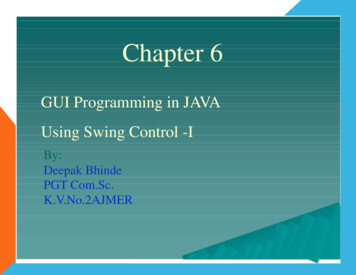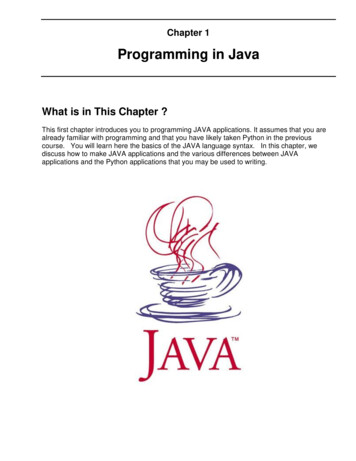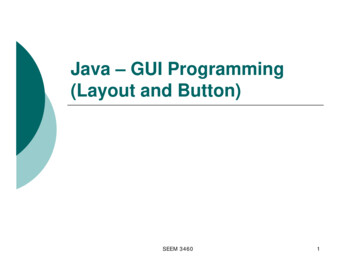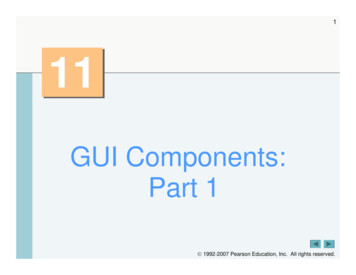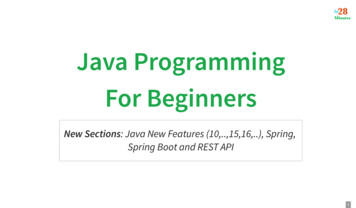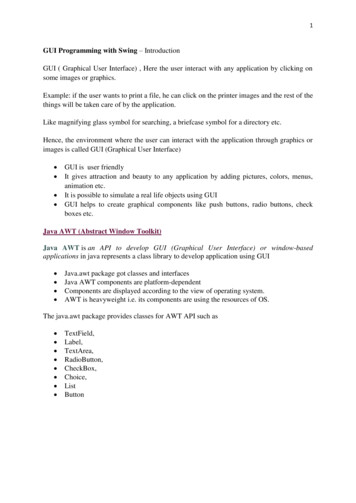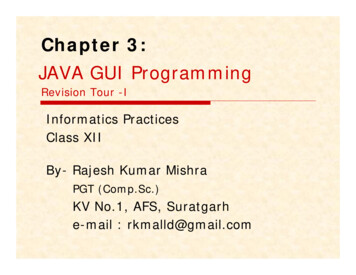
Transcription
Chapter 3:JAVA GUI ProgrammingRevision Tour -IInformatics PracticesClass XIIBy- Rajesh Kumar MishraPGT (Comp.Sc.)KV No.1, AFS, Suratgarhe-mail : rkmalld@gmail.com
What is JAVA? JAVA is an Object Orientedprogramming language as well aplatform. By using JAVA, we can write varioustypes of Application program forany type of OS and Hardware. JAVA is designed to buildinteractive, dynamic and secureapplications on network computersystem.
History of JAVAJAVA was started with a project (Green) to find to write applicationsfor electronic devices like TV-Set top Box etc. Which wasoriginally named Oak. Later renamed with JAVA.1991James Gosling developed Oak to program consumer electronic devices1995JAVA formally announced as a part of Netscape web browser.1996Java Development Kit (JDK) 1.0 by Sun Microsystems.1997JDK 1.1 launched with JAVA Servlet API1998Sun introduced community source “Open” and produces JDK 1.2 forLinux1999JDK 1.3 released and J2EE, J2SE,J2ME appeared2002JAVA Web Services Developer Pack released for Web Development.2005JAVA Enterprise System 2005Q4 released with integration of variousfeatures like monitoring, security etc. for Solaries, Windows etc.2006The Netbeans IDE 5.0 is released. Sun Open sourced Java EEcomponent as the Glassfish project to JAVA.net.
Characteristics of JAVA Write Once Run Anywhere (WORA)JAVA Program can be run on different platforms without anychanges. Light Weight CodeBig applications can be developed with small code. SecurityJAVA Programs are safe and secure. Built-in Graphics & Supports MultimediaJAVA is equipped with Graphics feature. It is best forintegration of Audio, Video and graphics & animation. Object Oriented LanguageJava is Object Oriented Language, near to real world. Platform IndependentChange of H/W and OS platform does not effect JAVAprogram. Open ProductIt is open i.e. freely available to all with no cost.
Why JAVA is Platform Independent?A program written in HLL must be converted into its equivalent Machine code,so that computer can understand and execute. This conversion is known asCompilation. Generally, the converted machine code depends on the H/w andOS platform. So, that a Windows program will not work on UNIX, or LINUX orMac platform etc. Since they are Platform dependent.A program written in JAVA is platform-independent i.e. they are not affected withchanging of OS. This magic is done by using Byte code. Byte code isindependent of the computer system it has to run upon.Java compiler does not produces Byte code instead of native executable codewhich is interpreted by Java Virtual Machine (JVM) at the time of execution.Java uses both compiler and interpreter.Java Interpreter (JVM)for MacintoshJavaProgramJavaCompilerJava ByteCodeProgramJava Interpreter (JVM)for WindowsJava Interpreter (JVM)for Unix
Basics of GUI How GUI application works ?Graphical User Interface (GUI) basedapplication contains Windows, Buttons, Textboxes, Dialogue boxes and Menus etc. knownas GUI components. While using a GUIapplication, when user performs an action, anEvent is generated. Each time an Event occurs,it causes a Message which sent to OS to takeaction. What is Event ?An Events refers to the occurrence of anactivity. What is Message ?A Message is the information/request sent tothe application.
GUI in JAVAIn Java, GUI features are supported through JFC (Java FoundationClasses). JFC comprises all the features which are needed to builda GUI application.Prier to Java 1.2 JFC components was called Abstract WindowsTools (AWT). After Java 1.2, a more flexible Swing Componentswas introduces.A GUI application in JAVA contains three basic elements.1. Graphical Component:It is an object that defines a screen element such as Button, Textfield, Menus etc. Each component has certain properties. They aresource of the Events. In java It is also known as Widget (WindowGadget). It can be container control or child control.2. Event:An Event (occurrence of an activity) is generated, when user doessomething like mouse click, dragging, pressing a key on thekeyboard etc.3. Event Listener:It contains method/functions which is attached to a component andexecuted in response to an event. In Java, Listener Interfacestores all Event-response-methods or Event-Handler methods.
Basic Graphical Controls of JAVA(Swing controls)The palette of controls in NetBeans IDE offers variousJava Swing, that can be used in Application frames/Window/ Form. Commonly used controls are jFrame: Used as a Basic Window or form.jLabel: Allows Non-editable text or icon to displayed.jTextField: allows user input. It is editable through text box.jButton: An action is generated when pushed.jCheckBox: Allow user to select multiple choices.jRadioButton: They are option button which can be turned onor off. These are suitable for single selection. jList: Gives a list of items from which user can select one ormore items. jComboBox: gives dropdown list of items or new item cab beadded. It is combination of jList jTextField. jPanel: It is container controls which contains other controlsusing a frame.
Events Handling in JAVA GUI ApplicationAn event is occurrence of some activities either initiated by user or bythe system. In order to react, you need to implement some Eventhandling system in your Application. Three things are important inEven Handling Event Source:It is the GUI component that generates the event, e.g. Button. Event Handler or Event Listener:It is implemented as in the form of code. It receives and handlesevents through Listener Interface. Event Object or Message:It is created when event occurs. It contains all the informationabout the event which includes Source of event and type of ent object /MessageReaction
Commonly used Events & ListenersJava API offers numerous types of events and event listeners. The commonly usedevents are Action Event:The Action events occurred when user completes an action on components likeJButton, JCheckBox, JTextField etc. To handle Action Event, ActionListnerinterface is used. Focus Event:The Focus event occurred when any components gains or loses focus oncomponents like JButton, JCheckBox, JTextField etc. To handle Focus Event,FocusListner interface is used. Key Event:The Key Event occurred when a key is pressed on the kryboard on inputenabled components, JTextField etc. To handle Key Event, KeyListnerinterface is used. Mouse Events:When a mouse is clicked, entered or leaved a component area of a control thenMouse event is generated. Any component can generate this event. To handleMouse Event, MouseListner interface is used. Window Event:Window Event occurred when user opens or closes a Window object. This eventis generated internally by the system. To handle Window Event,WindowListner interface is used.
JAVA character set Character set is a set of valid characters that alanguage can recognize. It may be any letter,digit or any symbol or sign. JAVA uses 2-Byte UNICODE character set,which supports almost all characters in almostall languages like English,Chinese, Arbic etc. In Unicode, first 128 characters are similar toASCII character set. Next 128 character equalto Extended ASCII code. Rest are capable tosupport other languages. Any character in Unicode can be representedby \u followed by 4 digit Hexadecimal number.E.g. \u0394 to represent Delta Symbol.
JAVA Tokens The smallest individual unit in a programis known as Token. It may any word,symbols or punctuation mark etc. Following types of tokens used in Java Keywords Identifiers Literals Punctuators (; [] etc) Operators ( ,-,/,*, , etc.)
Keywords in Java Keywords are the reserve words thathave a special meaning to the compiler. Key words can’t be used as identifiers orvariable name etc. Commonly used key words arechar, long, for, case, if, double, int,short, void, main, while , new etc.
Identifiers in Java Identifiers are fundamental building block of program andused as names given to variables, objects, classes andfunctions etc. The following rules must be followed while usingidentifiers. Identifiers may have alphabets, digits and dollar ( ),underscore ( ) sign. They must not be Java keywords. They must not begin with digit. They can be of any length. They are Case Sensitive ie. Age is different from age. Example of Valid identifiersMyFile, Date9 7 7, z2t09, A 2 Z, 1 to 100, chk etc. Example of Invalid identifiersDate-RAC, 29abc, My.File, break, for
Literals in Java Literals or constants are data items thathave fixed data value. Java allows several types of literals like Integer Literals Floating Literals Boolean Literals Character Literals String Literals The null literals
Integer Literals An integer constant or literals must have at leastone /- digit without decimal point. Java allows three types of integer literals Decimal Integer Literals (Base 10)e.g. 1234, 41, 97, -17 etc. Octal Integer Literals (Base 8)e.g.010, 014 (Octal must start with 0) Hexadecimal Integer Literals (Base 16)e.g. 0xC, 0xab (Hex numbers must starts with 0x) L or U suffix can used to represent long andunsigned literals respectively.
Floating / Real Literals A real literals are fractional numbers having at least onedigit before and after decimal point with or – sign.The following are valid real numbers2.0, 17.5, -13.0. -0.00626The following are invalid real numbers7, 7. , 17/2, 17,250.26 etc. A real literals may be represented in Exponent form havingMatissa and exponent with base 10 (E). Mantissa may be aproper real numbers while exponent must be integer.The following are valid real in exponent form152E05, 1.52E07, 0.152E08, -0.12E-3, 1.5E 8The following are invalid real exponent numbers172.E5, 1.7E, 0.17E2.3, 17,22E05, .25E-7
Other Literals The Boolean Literals represents either TRUE or FALSE. It alwaysBoolean type. A null literals indicates nothing. It always null type. Character Literals must contain one character and must enclosedin single quotation mark.e.g. ‘a’, ‘%’ , ‘9’ , ‘\\’ etc.Java allows some non-graphic characters (which can not be typeddirectly through keyboard) by using Escape sequence (\) .E.g.\a (alert),\b (backspace),\f (Form feed),\n (new line),\r (return key),\t (Horizontal tab),\v (vertical tab),\\ (back slash),\’ (single quote) ,\” (double quote) , \? (question mark), \0 (null) etc. String Literals is a sequence of zero or more characters enclosedin double quotes. E.g. “abs”, “amit” , “1234” , “12 A” etc.
Data types in JAVA Data types are means to identify the type of dataand associated operations of handling it.Java offers two types of data types. Primitive:These are in-built data types offered by thecompiler. Java supports 8 primitive data typese.g. byte, short, int, long, float, double, char,boolean. Reference:These are constructed by using primitive datatypes, as per user need. Reference data typesstore the memory address of an object. Class,Interface and Array are the example of ReferenceData types.
Data Types in JavaData ng Data type is also used in Java as Reference data typeArrays
Primitive Data typesTypeSizeDescriptionRangebyte1 ByteByte integer-128 to 128short2 ByteShort integer-32768 to 32767int4 Byteinteger-231 to 231-1long8 ByteLong integer-263 to 263-1float4 ByteSingle precision floatingpoint (up to 6 digit)-3.4E 38 to 3.4E 38double8 ByteDouble precision floating(up to 15 digit)-1.7E 308 to 1.7E 308char2 ByteSingle character0 to 65536Boolean1 ByteLogical Boolean valuesTrue or False L suffix can used to indicate the value as long. By default Java assume frictional value as double, F and D suffix can beused with number to indicate float and double values respectively.
Working with Variables A variable is named memory location, which holds a datavalue of a particular data type. Declaration and Initialization of variable data type variable Name ;Example:int age;double amount;double price 214.70, discount 0.12;String name “Amitabh”long x 25L;byte a 3;float x a b; By default all Numeric variables initialized with 0, andcharacter and reference variable with null, boolean withfalse, if it is not initialized. The keyword final can be used with variable declaration toindicate constant.E.g. final double SERVICE TAX 0.020
Text interaction in JAVA GUIsIn GUI application often we require to store the values of text fields tovariable or vice-versa. Java offers three method for this purpose- getText():It returns the text stored in the text based GUI components like TextField, Text Area, Button, Label, Check Box and Radio Button etc. in stringtype.e.g. String str1 jTextField1.getText(); parse .()This method convert textual data from GUI component in to numeric type.Byte.parseByte(String s)Short.parseShort(String s)Integer.parseInt(string s)Long.parseLong(string s)Float.parseFloat(string s)Double.parseDouble(string er.long.float.double.int age Integer.parseInt(jTextField1.getText()); setText()This method stores string into GUI component.e.g. (“” payment);
Displaying Dialogue Boxes in JAVA GUIsIn GUI application often we require to display a message inthe Dialog Boxes containing OK button to close the DialogBox. The following steps can be used to display a messagein a dialog box. Firstly, you need to import jOptionPane swing control at thetop of program code, by typing -import javax.swing.JoptionPane; When required you may display a message by followingcode in a method-JOptionPane.showMessageDialog(null, “Hello. “); In non-GUI application or at console window you may useSystem.out.print() method to display a message.e.g. System.out.print(“Hello ”);System.out.println(“How are you?”);
A sample Java Program// A non-GUI Program to calculate area of circle//import java.io.*;class MyProgram{public static void main(String arg[]) throws IOException{final float PI 3.14;float a;int r 5;a PI*(r*r);System.out.println(“Area of circle “ a);System.out.println(“Bye ”);}}
Operators in Java The operators are symbols or words, whichperform specified operation on its operands. Operators may Unary, Binary and Turnery as pernumber of operands it requires. Java offers the following types of Operators: Arithmetic Operator Increment/Decrement Operator Relational or Comparison Operators Logical Operators Assignment Operators Other Operators.
1. Arithmetic Operators Unary plusRepresents positivevalues.int a 25;-Unary minusRepresents negativevalues.int a -25; AdditionAdds two valuesint x a b;-SubtractionSubtract secondoperands from first.int x a-b;*MultiplicationMultiplies two valuesint x a*b;/DivisionDivides first operandby secondint x a/b;%Modulus(remainder)Finds remainder afterdivision.int x a%b; Concatenate orString additionAdds two strings“ab” ”cd” ”abcd”“25” ”12” ”2512”“” 5 ”5”“” 5 ”xyz” ”5xyz”
2. Increment & Decrement Operator Java supports and -- operator which addsor subtract 1 from its operand. i.e.a a 1 equivalent to a or a a a-1 equivalent to --a or a- or -- operator may used in Pre or Postform. a or --a (increase/decrease before use)a or a– (increase/decrease after use)Ex. Find value of P? (initially n 8 and p 4)p p* --n; 28p p* n--; 32Ex. Evaluate x y 2y if y 6. 7 14 21
3.Relational Operator Relational operators returns true or false as per therelation between operands. Java offers the following six relational operators. less than less than or equal to greater than greater than or equal to equal to! not equal toRelational operators solved from left to right.Ex: 3 3 true3! 3 falsea b true if a and b have the same value.a b c (a b) c true if a is smallest.
4.Logical Operator Logical operators returns true or false as per the condition ofoperands. These are used to design more complex conditions. Java offers the following six (5 binary and 1 unary) logicaloperators.OperatorNameuseReturns true if&&Andx&&yX and y both true Orx yEither x or y is true!Not!xX is false&Bitwise andx&yX and y both true Bitwise orx yEither x or y is true Exclusive orx yIf x and y are differentEx: 5 8 5 2 (false)6 9 && 4 2 (true)!(5! 0) (false)1 0 0 1 (false)6 3&&4 4 (false)!(5 9) (true)
5.Assignment Operator In Java operator is known as Assignment operator, itassigns right hand value to left hand variables.Ex: int x 5;z x y; Java offers some special shortened Assignment operators,which are used to assign values on a variable.OperatoruseEquivalent to X yX x y- X- yX x-y* X* yX x*y/ x/ yX x/yX% yX x%y% Ex:x- 10 x x-10x% y x x%y
6. Other Operators In Java some other operators are also used for variousoperations. Some operators areOperator?:Shortcut of If condition (turnery operator) Condition ? true action : false action []Used to declare array or access array element.Used to form qualified name (refer)(type)new , Converts values as per given data typeCreates a new objectinstanceofEx.Equivalent toDetermines whether the first operator is instance of other.Performs bitwise left shift or right shift operation.(compliment) Inverts each bit (0 to 1 or 1 to 0)result marks 50 ? ‘P’ : ‘F’6 4 ? 9:7 evaluates 9 because 6 4 is true.
Operator’s Precedence Operator’s precedence determines the order in which expressions are evaluated.There is certain rules for evaluating a complex expression.e.g. y 6 4/2 (why 8 not 5 ?)OperatorsRemarkAssociativity() used to make a group, [] used for array and . Isused to access member of objectL to RReturns true or false based on operandsR to LNew is used to create object and (type) is used toconvert data into other types.R to LMultiplication, division and modulusL to R -Addition and SubtractionR to L ! Equality and not equalityL to R&Bitwise AndL to R Bitwise Exclusive OrL to R Bitwise orL to R&&Logical AndL to R Logical orL to R?:Shortcut of IFR to LVarious Assignment operatorsR to L. [] () -- ! New (type)*/% - * / %
Expression in Java An expression is a valid combination of operators, constantsand variable and keywords i.e. combination of Java tokens. In java, three types of expressions are used. Arithmetic ExpressionArithmetic expression may contain one or more numeric variables,literals and operators. Two operands or operators should not occurin continuation.e.g. x *y and q(a b-z/4) is invalid expressions.Pure expression: when all operands are of same type.Mixed expressions: when operands are of different data types. Compound ExpressionIt is combination of two or more simple expressions.e.g. (a b)/(c d)(a b) (b c) Logical ExpressionLogical or Boolean expression may have two or more simpleexpressions joined with relational or logical operators.e.g. x y(y z) (x/z)x y && z(x)(x-y)
Type Conversion in JAVA The process of converting onepredefined type into another is calledtype conversion. In mixed expression, various types ofconstant and variables are convertedinto same type before evaluation. Java facilitates two types of conversion. Implicit type conversion Explicit type conversion
Implicit Type Conversion It is performed by the compiler, when different data typesare intermixed in an expression. It is also called Coercian. In Implicit conversion, all operands are promoted(Coercion) up to the largest data type in the expression.Ex. Consider the given expression, where f is float, d is doubleand I is integer data type.Result (f * d) -( f i)doublefloatdouble ( f / i)float
Explicit Conversion in JAVA An explicit conversion is user defined that forces to convertan operand to a specific data type by (type) cast.Ex. (float) (x/2) suppose x is integer.The result of x/2 is converted in float otherwise it will giveinteger result. In pure expression the resultant is given as expression’sdata type.e.g. 100/11 will give 9 not 9.999 (since both are integer) In mixed expression the implicit conversion is applied(largest type promotion)e.g. int a, mb 2, k 4 then evaluatea mb*3/4 k/4 8-mb 5/8 2*3/4 4/4 8–2 5/8 6/4 1 8–2 5/8 1 1 8–2 0(6/4 will give 1 ) 8
JAVA Statements A statement in Java is a complete unit of execution. Itmay consists of Expression, Declaration, Control flowstatements and must be ended with semicolon (;) Statements forms a block enclosed within { }. Even ablock may have no statement (empty).E.g.If(a b){ . .} Note:System.out.print(‘h’ ’a’) will give 169System.out.print(“” ‘h’ ’a’) will give haSystem.out.print(“2 2 ” 2 2) will give 2 2 22System.out.print(“2 2 ” (2 2)) will give 2 2 4
Programming Constructs in JAVA In general a program is executed from begin to end.But sometimes it required to execute the programselectively or repeatedly as per defined condition.Such constructs are called control statements. The programming constructs in Java, are categorized into - Sequence:Statements are executed in top- down sequence. Selection (conditional):Execution of statement depends on the condition,whether it is True or False.(Ex. if., if else, switch constructs) Iteration (Looping):Statement is executed multiple times (repetition) tillthe defined condition True or False.(Ex. for. , while , do.while loop constructs)
Diagrammatic RepresentationStatement 1TrueConditionStatement 2Statement 3Statement (s)FalseStatement (s)Selection constructSequence constructFalseConditionIterationConstructExit fromloopStatement (s)True
Selection statement (if.) The if statement is used to test a condition. If definedcondition is true the statements are executed otherwisethey are ignored. The condition may be simple or complex (using &&, etc.) and must be enclosed in ( ). Expression defined as condition must be evaluated asTrue or False.Syntaxif (condition){statement 1 ; .}if ( num 0) {jLable1.setText(“Number is positive”);}if ( ch ‘0’ && ch ‘9’ ) {jLable1.setText(“It is digit”);}In case of single statement in if the use of {} is optional.
Selection statement (if.else.) The if else. also tests condition. If defined condition istrue the statements in True block are executed otherwiseelse block is executed.if (condition){statement 1 ; .}else{statement 2; .}if ( num 0) {jLable1.setText(“Number is positive”);}else{jLable1.setText(“Number is zero or negative”);}if ( age 18)jLable1.setText(“Eligible to Vote”);elsejLable1.setText(“Not eligible to Vote”);In case of single statement {} is optional.
Nested if. An if or if.else. may have another if. Statement in its trueblock or in false block. It is known as Nesting of if (placing anif inside another if).if (condition1){if ( num 0)if(condition 2){{ .jLable1.setText(“Number is positive”);}}elseelse{ { if (num 0)}jLable1.setText(“Number is negative”);else{elseif(condition 3){ .}else{ }}jLable1.setText(“Number is zero”);}Nested if. block
If else If ladder When a else block contains another if. and this nested else blockmay have another if and so on. This nesting is often known asif.else.if ladder or staircase.if (condition1)statement 1;elseif (condition 2)statement 2;elseif (condition 3)statement 3;elseif(condition 4)statement 4; elsestatement n;if (day 1)jLable.setText(“Sunday”);elseif (day 2)jLable.setText(“Monday”);elseif (day 3)jLable.setText(“Tuesday”);elseif(day 4)jLable.setText(“Wednesday ”);elseif(day 5)jLable.setText(“Thrusday”);elseif(day “Saturday”);
Conditional operator and if. statement The ? : (conditional operator) may be used as alternativeto if.else. statement in Java. In contrast to if , ?: is more concise and compact code itis less functional. ?: produces an expression so that a single value may beincorporated whereas if. is more flexible, whereas youmay use multiple statements, expressions andassignments. When ?: is used as nested form, it becomes more complexand difficult to understand.SyntaxExpression 1 ? Expression 2: expression 3;if ( a b)c a;elsec b;C a b ? a : b ;
The switch statement Multi-branching selection can be made in Java by using switch statement. It test successively, the value of an expression (short, int, long or chartype), when match is found, the statements associated with constant isexecuted.switch ( expression ){ case const 1 : statement (s);break;case const 2 : statement (s);break;case const 2 : statement (s);break; .[default : statement (s);]}1. No two identical constant can be used.2. Default. is optional may be anywhere inswitch block.switch (day){ case 1 : Dow “Sunday”;break;case 2 : Dow “Monday”;break;case 3 : Dow “Tuesday”;break;case 4 : Dow “Wednesday”;break;case 5 : Dow “Thursday”;break;case 6 : Dow “Friday”;break;case 7 : Dow “Saturday”;break;default : Dow “Wrong Input”;}jLable.setText(“Weak day” Dow);
Switch and if.else statementThe switch and if.else both are used to make a selection constructin Java, but there some differences. Switch can test only equality whereas if. Can evaluate any typeof relational or logical expression. In switch a single value or constant can be tested but in if.more versatile expression can be tested. The switch statement can handle only byte, short, int or charvariable but If. can test more data type like float, double orstring etc.Nesting of switch with switch or if. may be used .if ( condition 1){ switch (exp1){ . .}}else{ .;}switch (exp 1){ case cont :switch (exp2){ . .} }
Iteration (looping) statements Iteration or looping allow a set of instructions to beexecuted repeatedly until a certain condition is true or false. As per placing of condition to be tested, a loop may beEntry-controlled or Exit-controlled loop. In Entry controlledloop, a condition is tested (pre test) before executing thestatements. Whereas in Exit-controlled statements areexecuted first then condition is tested (post test), whichensures at least on time execution of statements. As per number of execution, a loop may be Countercontrolled or Sentinel loop. Counter controlled loops areexecuted fixed number of times, but sentinel loop may bestopped any time by giving its sentinel value. i.e. number ofexecution can not be forecasted. A body of loop contains a block, having statements to beexecuted.
The for . loopIn simple use, a for. Loop is Entry-controlled and countercontrolled loop having fixed number of iteration.for (initialization exp (s) ; condition ; update exp (s) ){ . .Looping statements}for (int i 1; i 10 ; i ) {System.out.println (“” i);}//loop to find even nos. up to 50for (int i 0; i 50 ; i i 2)System.out.println (“” i);//loop to find factorialint fact 1,num 5;for (int i 1; i num ; i )fact fact * i;System.out.println (“factorial ” fact);//loop to get sum of first 10 nos.int sum 0;for (int i 1; i 10 ; i ) {sum sum i;}System.out.println (“” sum);
Variation in for. loop Multiple initialization and update expressionA for. Loop may contain multiple initialization and/or updateexpressions separated by (,)for (i 0,sum 0;i n; sum , i ) Optional ExpressionsIn for loop initialization, condition and update section may beomitted. Note that (;) must be present.for ( ; i n ; ) Infinite loopFor. Loop may be endless (infinite) when defined condition isalways true or it is omitted.for ( ; ; ) Empty loopfor. Loop may not contain any statement in looping body i.e.Empty loop. If (;) placed after for. Loop then empty loop iscreated.for (int i 1; i 300 ; i ) ; Variable declared inside for. Loop can’t accessed outside the loop.Since it is out of scope.
The while. loopIn simple use, a while . Loop is Entry-controlled and countercontrolled or sentinel looping statement, which executesstatements until defined condition is true.while (condition){ . .}Looping statements//while loop to find factorialint i 1;while ( i 10) {i i 1;System.out.println (“” i);}int fact 1,num 5,i 1;while (i num){ fact fact * i;i ;}System.out.println (“factorial ” fact);A while loop also may be empty or infinite
The do.while loopUnlike for. and while. Loop, do.while loop is Exit-controlled and countercontrolled or sentinel looping statement, which executes statementsuntil defined condition is true. It always executes at least once.do{ . .Looping statements} while (condition);// do. Loop to print A – Z letters//do. loop fixed timechar ch ‘A’;do {int i 1;doSystem.out.println (“” i);ch ;} while (ch ‘Z’);{System.out.println (“” i);i ;} while (i 10);A do while loop also may be empty or infinite
Which loop is better ? Java offers three looping statements i.e. for.,while. and do.while. There are somesituation where one loop is more appropriatethan others. The for loop is best suited where number ofexecution is known in advance. (fixedexecution) The while and do. Are more suitable in thesituations where it is not known that whenloop will terminate. (unpredictable times ofexecution). The do. Loop ensures at least one time ofexecution since it is Exit-controlled loop.
Jump statement in Java Java offers three jump statements (return, break andcontinue), which transfers the control else whereunconditionally. The return statement can be used any where in theprogram. It transfers the control to calling module orOperating System. However Java provides System.exit()method to stop the execution of program. The break is used with for., while, do. and switchstatements which enables the program to skip over somepart of the code and places control just after the nearestclosing of block. It is used to terminate the loop. The continue statement is used within looping statement(not with switch) and works like break i.e. it also skips thesta
GUI in JAVA In Java, GUI features are supported through JFC (Java Foundation Classes). JFC comprises all the features which are needed to build a GUI application. Prier to Java 1.2 JFC components was called Abstract Windows Tools (AWT). After Java 1.2, a more flexible Swing Components was introduces. A GUI application in JAVA contains three .
